Many will remember the ‘100 days or its free’ offer between Elon Musk and Mike Cannon-Brookes back in 2017.
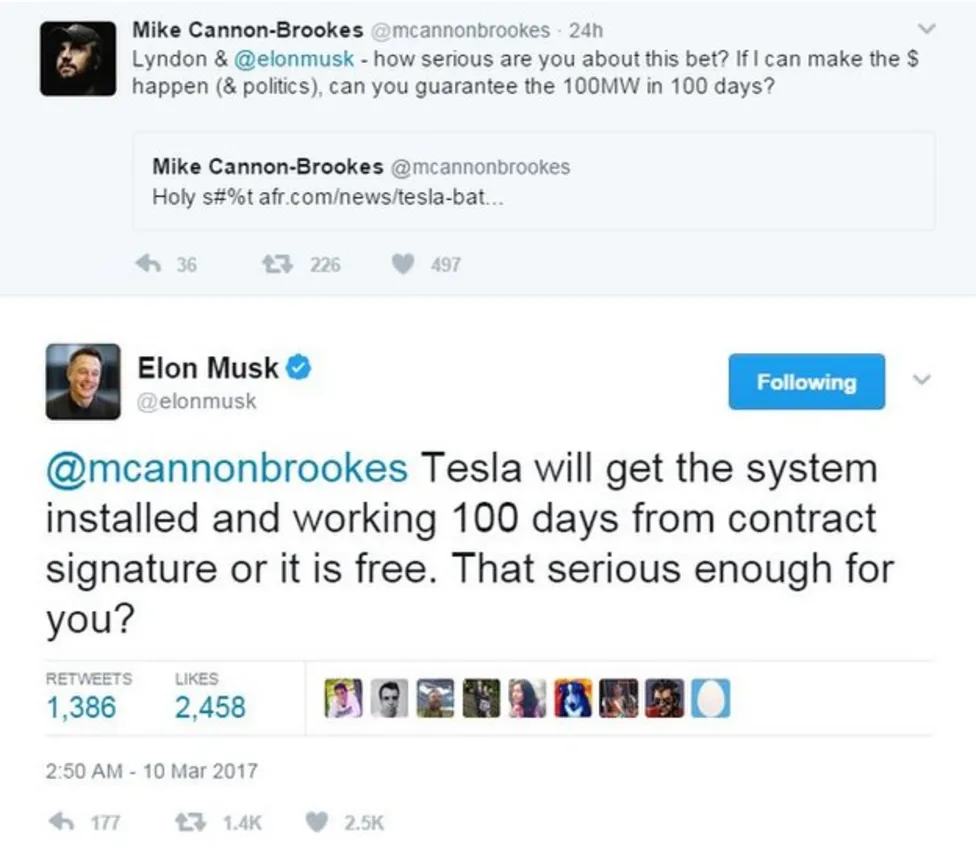
That exchange was almost exactly 7 years ago – back when Mike Cannon-Brookes was merely an energy spectator, and Elon Musk was merely a Twitter user. Much has happened since then..
The Hornsdale Power Reserve was indeed installed within the 100 days, although it took roughly 11 months for the project to go from ‘tweet’ to full operations. Also since then, the NEM’s battery fleet has grown from that original lone big battery, to a total of twenty registered systems with a combined power capacity of 1,632 MW and an energy storage capacity of 2,405 MWh.
Last week I published a short review of the financial performance for those twenty batteries over 2023, which I composed largely using data from our GSD2023 released several weeks beforehand. In the second part here I have decided to explore the development timelines of each of these projects, to understand the historical speed of delivery.
Given the ‘100 days’ promise that kicked off the battery boom, and which no doubt sticks in the minds of many, we wondered about how true delivery times for each subsequent BESS project compared.
A timeline of BESS development in the NEM
With a bit of detective work, I have compiled a list of key development milestones for each of the twenty batteries currently registered in the NEM, and have attempted to plot them on the Gantt chart shown below.
For these projects, companies traditionally post press releases when a battery ‘completes construction’ or ‘enters commissioning phase’ or ‘reaches energisation’ – these milestones often reflect terms set within contracts. Far less reported is the date when each battery is fully operational, which is thus the time from which it can be relied upon for system security (and when companies can expect ongoing market revenue).

A Gantt chart of battery development in the NEM, using definitions below. Click here to see a higher-resolution version of the chart.
Source: GSD2023 Data Extract, NEMreview. Other sources are stated in the table below.
In the Gantt chart above I have used my own definitions for consistency:
- First Announcement: Marks the date that the company first publicly unveiled the project. Feasibility studies, contract negotiations and detailed design work typically begin before this point in time. This is a notable milestone as it is a signal of when the market, and system planners generally start to anticipate the project.
- FC: Date of Financial Close or Final Investment Decision for the project, or in the case of Government-initiated contracts, the date when ‘notice to proceed’ was given.
- Construction and Early Commissioning: For this analysis, this period begins from the first announcement of construction commencing (i.e. ground broken), and ends at the time when ‘Partial Operation’ (defined below) begins.
- Partial Operation: Begins from the date of first power output or input via AEMO’s MMS. I have used our NEMreview software to examine the InitialMW data field here.
- Full Operation: Marks when the battery’s generation or load DUID maximum daily availability was at its full capacity for more than half of a calendar month. Or where more appropriate, the first month of material FCAS bidding. I have used our GSD2023 data extract to determine these dates.
Further, I will also caveat the chart above with the following points:
- The timeline is indicative only. The source of references for each date is presented in the table below.
- Due to the definitions above, partial operation period is likely to overlap actual construction periods in some cases.
- Project expansions (e.g. the 2020 expansion of Hornsdale) are not included in the timeline.
Using the definitions stated above, I have also charted the length of each project’s development time, by two measures, counted in an approximate number of months.
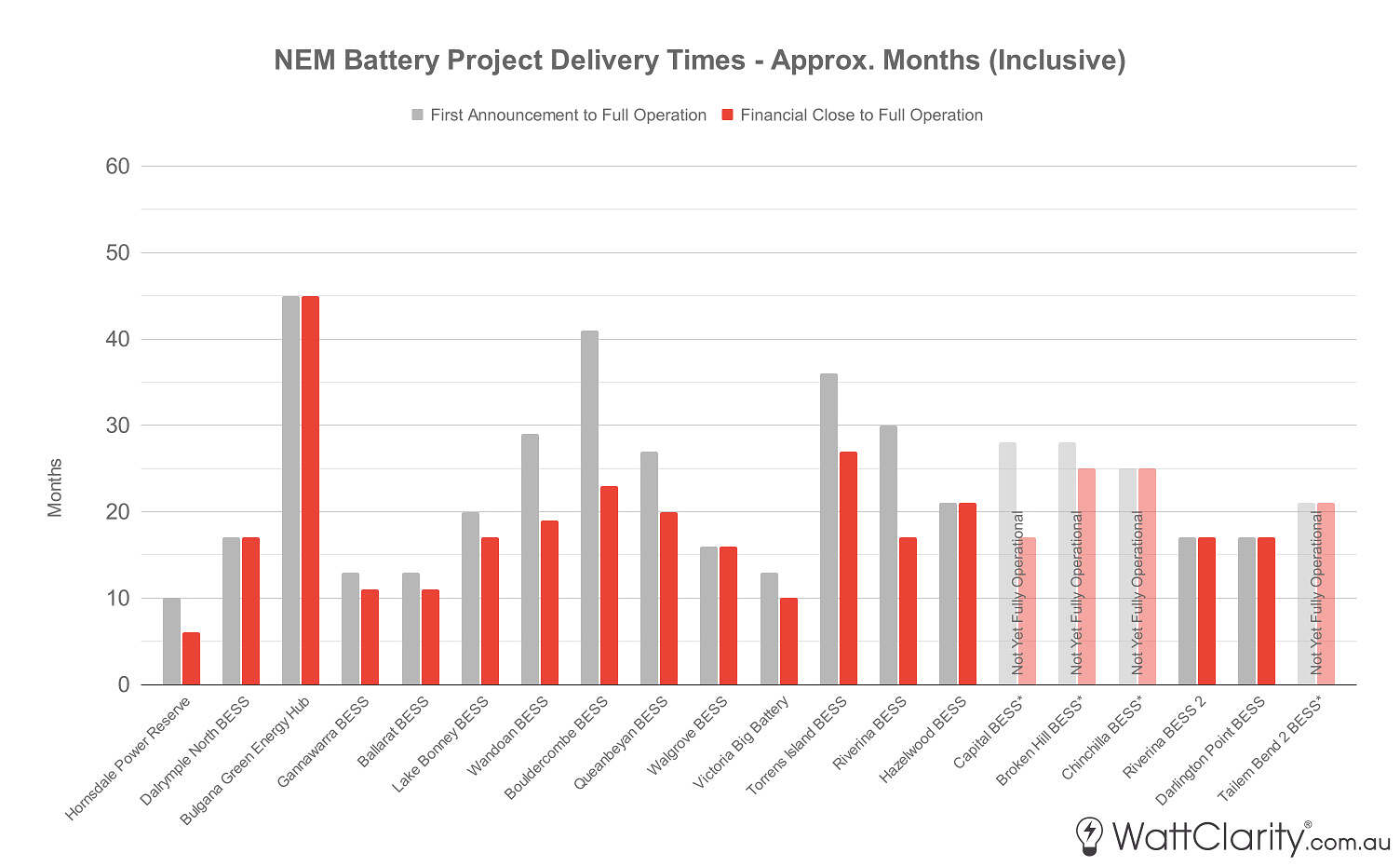
Project delivery times for each BESS (in approximate number of months).
Source: GSD2023 Data Extract. Other sources stated in table below.
It should be obvious that COVID and post-COVID supply chain constraints played some role in project delivery times, although one might expect (or hope) this to be diminishing over time.
From the two charts above, there are a few observations that stand out to me:
- Hornsdale was an (extreme) outlier in terms of speed of delivery.
- Project delivery times vary significantly – even between projects that were developed by the same company.
- The quickest projects, particularly those of scale, had significant state government or TNSP involvement (e.g. Hornsdale, VIC Big Battery, etc.)
- In the case of some conjoined projects, Bulgana especially – delays and slowness of delivery can be somewhat attributed to the battery being built in tandem with a wind or solar farm, as development risk is likely to increase with project scale and complexity. This is an important factor going forward as we are seeing a significant increase in hybrid projects.
Key dates for each project, with references
| Project | Approximate Length of Delivery (inclusive) |
Development Milestones, Notes and References |
|
Hornsdale Power Reserve
Image Source: Neoen |
From First Announcement to Full Operations: 10 months From Financial Close to Full Operations: 6 months *Note this does not include the later expansion of the battery in 2020. |
March 10th 2017– Elon Musk tweeted the infamous ‘100 days or it’s free’ offer. One week later the South Australian Government officially launched a bidding process to build a 100MW battery in the state.
July 6th 2017 – A project agreement was signed by Neoen, Tesla and the South Australian Government. Construction began shortly after. November 24th 2017 – The Hornsdale Power Reserve charged its first megawatts, sourced via NEMreview. |
|
Dalrymple North BESS
Image Source: ElectraNet |
From First Announcement to Full Operations: 17 months From Financial Close to Full Operations: 17 months |
August 17th 2017 – Notice to proceed was given, and the final investment decision by the ElectraNet Board was made some weeks later. One week later, ARENA officially announced the project as ‘South Australia’s second big battery’.
October 2017 – Design work packages and construction works progressively began to be completed, according to ElectraNet. July 5th 2018 – The Dalrymple North BESS charged its first megawatts, sourced via NEMreview. |
| Bulgana Green Power Hub
Image Source: Neoen |
From First Announcement to Full Operations: 45 months From Financial Close to Full Operations: 45 months |
December 2017 – The Victorian Government announced a 15-year support agreement with Neoen has been signed for the Bulgana Green Power Hub – a combined wind farm and battery storage plant.
March 21st 2018 – Neoen CEO Franck Woitiez told RenewEconomy that construction had begun. February 19th 2020 – Neoen sought “liquidated damages” due to ongoing connection delays for the project, RenewEconomy reports. July 1st 2021 – The Bulgana BESS discharged its first megawatts, sourced via NEMreview.
|
| Gannawarra BESS
Image Source: EnergyAustralia |
From First Announcement to Full Operations: 13 months From Financial Close to Full Operations: 11 months |
January 31st 2018 – EnergyAustralia owner CLP noted both the Gannawarra and Ballarat BESS projects in their 2018 sustainability report released on this date.
March 23rd 2018 – PV Magazine reported that financing had been completed for the project and the imminent commencement of construction. November 8th 2018 – The Gannawarra BESS charged its first megawatts. Sourced via NEMreview. |
| Ballarat BESS
Image Source: Twitter, Lily D’Ambrosio |
From First Announcement to Full Operations: 13 months
|
January 31st 2018 – EnergyAustralia owner CLP noted both the Gannawarra and Ballarat BESS projects in their 2018 sustainability report.
March 5th 2018 – The project reached financial close, as reported by AusNet Services. April 2nd 2018 – AusNet Services reported that mobilisation of construction materials had commenced. November 7th 2018 – The Ballarat BESS charged its first megawatts. Sourced via NEMreview. |
| Lake Bonney BESS
Image Source: ARENA |
From First Announcement to Full Operations: 20 months
From Financial Close to Full Operations: 17 months |
May 10th 2018 – RenewEconomy reported that Infigen Energy (Now Iberdrola) had submitted an application to the South Australian Planning Commission for the project.
August 15th 2018 – RenewEconomy reported that the project will proceed having secured funding, with construction to commence shortly. October 16th 2019 – The Lake Bonney BESS charged its first megawatts. Sourced via NEMreview.
|
| Wandoan BESS
Image Source: Consolidated Power Projects |
From First Announcement to Full Operations: 29 months
From Financial Close to Full Operations: 19 months |
January 29th 2020 – Vena Energy announced the Wandoan BESS project.
November 2020 – Contractor NRG services states that construction of the BESS commenced in this month – with negotiations and construction delayed due to COVID-19 disruptions. September 8th 2021 – The Wandoan BESS charged its first megawatts. Sourced via NEMreview. |
|
Bouldercombe BESS
Image Source: Genex Power |
From First Announcement to Full Operations: 41 months
From Financial Close to Full Operations: 23 months |
August 2020 – In a corporate presentation released via the ASX, Genex announced the commencement of ‘Project Como’. The following month in a separate company announcement, Genex stated a land access agreement with Powerlink had been reached.
February 25th 2022 – The company’s half-year report stated that the project reached financial close, with early construction tasks due to commence immediately. August 8th 2023 – The Bouldercombe BESS discharged its first megawatts. Sourced via NEMreview. |
|
Queanbeyan BESS
Image Source: Elecnor Australia |
From First Announcement to Full Operations: 27 months
From Financial Close to Full Operations: 20 months |
September 15th 2020 – The ACT Government awarded GPG a contract to build the 20MWh battery project, in addition to the Berrybank Stage-2 Wind Farm.
April 2021 – GPG confirmed construction commenced approximately around this time – with engineering company Elecnor later reporting a contract was signed for the project. July 5th 2022 – The Queanbeyan BESS charged its first megawatts. Sourced via NEMreview. |
| Walgrove BESS
Image Source: Lumea |
From First Announcement to Full Operations: 16 months From Financial Close to Full Operations: 16 months |
October 23rd 2020 – RenewEconomy reported the first announcement from TransGrid that the Wallgrove Battery would proceed.
February 2021 – On the project’s summary page, Transgrid states that construction for the project began in February 2021. October 29th 2021 – The Walgrove BESS discharged its first megawatts. Sourced via NEMreview. |
|
Victorian Big Battery
Image Source: AusNet Services |
From First Announcement to Full Operations: 13 months
From Financial Close to Full Operations: 10 months |
November 5th 2020 – The office of the Victorian premier released a public announcement unveiling the VIC Big Battery.
February 26th 2021 – State government website InvestVictoria reported that Neoen had secured financing for the project, also stating that construction had recently commenced. July 28th 2021 – The VIC Big Battery discharged its first megawatts. Sourced via NEMreview. |
|
Torrens Island BESS
Image Source: AGL |
From First Announcement to Full Operations: 36 months
From Financial Close to Full Operations: 27 months |
November 16th 2020 – Then-CEO of AGL, Brett Redman, unveiled the project in a press release.
August 12th 2021 – In their FY21 Full-Year results presentation, AGL announced that FID has been reached on the Torrens Island Battery. November 29th 2021 – AGL posted a media release that ground has been broken for the construction of the battery project. April 26th 2023 – The Torrens Island BESS charged its first megawatts. Sourced via NEMreview. |
| Riverina BESS
Image Source: Lumea |
From First Announcement to Full Operations: 30 months
From Financial Close to Full Operations: 17 months |
May 25th 2021 – Shell and Edify announced that they are teaming up to build a ‘100MW BESS’ in Southern New South Wales, as reported by RenewEconomy.
June 14th 2022 – Edify Energy announced that the original project had now been split into three components (Riverina BESS, the Riverina BESS 2 and the Darlington Point BESS), and financial close had been reached on all three projects. Site establishment and early civil works began for the project on June 20th, according to contractors Consolidated Power Projects. June 2nd 2023 – The Riverina BESS discharged its first megawatts. Sourced via NEMreview. |
|
Hazelwood BESS
Image Source: Engie, Eku Energy, Fluence |
From First Announcement to Full Operations: 21 months
From Financial Close to Full Operations: 21 months |
November 30th 2021 – Reuters reported the announcement of the joint project between Macquarie Group, Engie, and Fluence. Macquarie’s Green Investment Group also report that the project is financially committed, and construction has already begun.
March 10th 2023 – The Hazelwood BESS discharged its first megawatts. Sourced via NEMreview. |
|
Capital BESS
Image Source: Doosan GridTech |
From First Announcement to Full Operations: Not yet fully operational From Financial Close to Full Operations: Not yet fully operational |
December 14th 2021 – RenewEconomy’s Giles Parkinson reported that Neoen had begun construction after winning the 2020 tender with the ACT Government. It wasn’t until October 5th 2022 that Neoen announceed that it has reached financial close on the project.
November 7th 2023 – PV Magazine reported the Capital BESS faces significant delays due to connection compliance testing. July 25th 2023 – The Capital BESS charged its first megawatts. Sourced via NEMreview. |
|
Broken Hill BESS
Image Source: Energy Magazine |
From First Announcement to Full Operations: Not yet fully operational From Financial Close to Full Operations: Not yet fully operational |
December 20th 2021 – AGL announced it had received planning approval for the project from the NSW government.
March 25th 2022 – AGL posted a press release confirming the Final Investment Decision for the project. October 2022 – AGL announced construction commenced in this month, after a delay of 4 months due to COVID-related supply chain issues. December 1st 2023 – The Broken Hill BESS discharged its first megawatts. Sourced via NEMreview. |
|
Chinchilla BESS
Image Source: CS Energy |
From First Announcement to Full Operations: Not yet fully operational
From Financial Close to Full Operations: Not yet fully operational |
March 31st 2022 – As reported by PV Magazine’s David Carroll – CS Energy announced plans for the Chinchilla Battery, shortly after a notice to proceed was issued.
July 15th 2022 – CS Energy published a LinkedIn post of the first Downer Construction workers on site. December 16th 2023 – The Chinchilla BESS charged its first megawatts. Sourced via NEMreview. |
|
Riverina BESS 2
Image Source: Michelle Grogan |
From First Announcement to Full Operations: 17 months From Financial Close to Full Operations: 17 months |
June 14th 2022 – RenewEconomy reported that the original Riverina BESS project will be split into three components – with EnergyAustralia taking operational control over the Riverina BESS 2. Edify Energy announced that financial close has been reached on all three projects.
June 20th 2022 – Site establishment and early civil works began on the project, according to contractor Consolidated Power Projects. June 25th 2023 – The Riverina BESS 2 discharged its first megawatts. Sourced via NEMreview. |
|
Darlington Point BESS
Image Source: Edify |
From First Announcement to Full Operations: 17 months From Financial Close to Full Operations: 17 months |
June 14th 2022 – Edify Energy announced that financial close has been reached on the Riverina BESS, the Riverina BESS 2 and the Darlington Point BESS.
June 20th 2022 – Project contractor, Consolidated Power Projects, reported this as the date of the commencement of construction (inclusive of site establishment, civil earthworks and concrete works). June 23rd 2023 – The Darlington Point BESS discharged its first megawatts. Sourced via NEMreview. |
|
Tailem Bend 2 BESS
Image Source: ElectraNet
|
From First Announcement to Full Operations: Not yet fully operational
|
July 20th 2022 – Vena Energy posted a press release unveiling the Tailem Bend 2 Hybrid Project (containing the BESS), with financial close of the project completed.
January 2023 – Vena Energy confirmed early construction works began on the hybrid project in this month, it was originally expected that construction would begin in October 2022. October 27th 2023 – The Tailem Bend 2 BESS discharged its first megawatts. Sourced via NEMreview. |
If you spot any errors in the table above, please leave a comment.


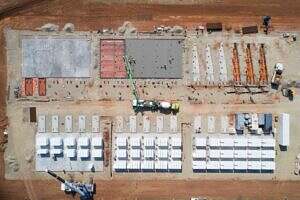
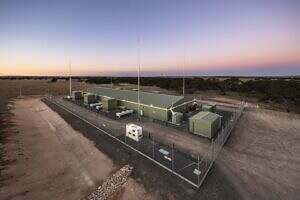
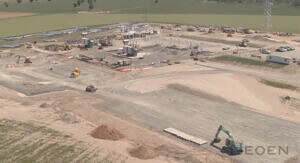
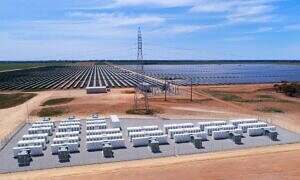
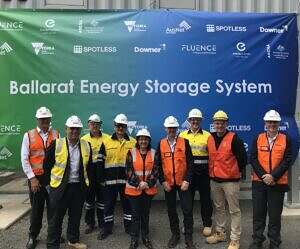
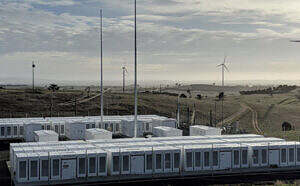

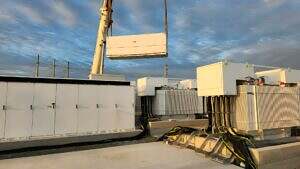
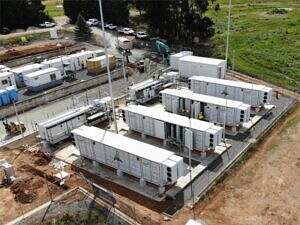
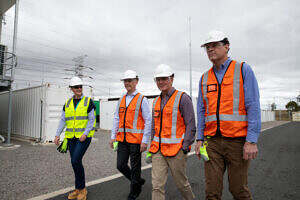
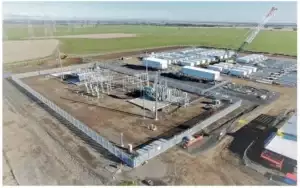
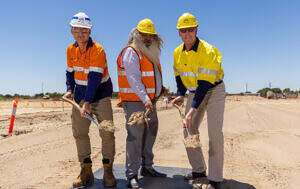
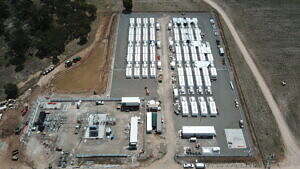

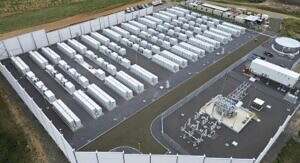
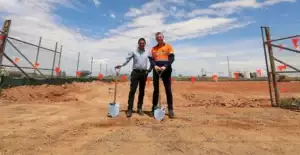
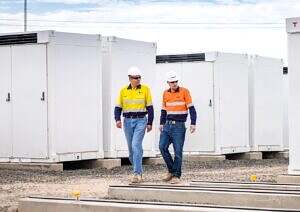
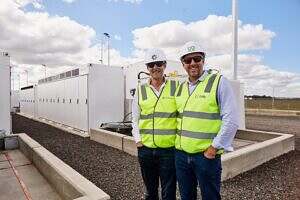
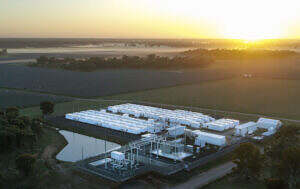
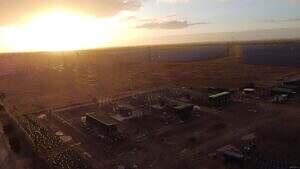
Dan,
Thanks – another thought-provoking article. It was a difference world 7 years ago, pretty much halfway through it’s design life and 100MWh for $56-90m.
How much have the cost of grid scale batteries dropped since then?
Interesting to compare these to the Kurri Kurri peaking station. It will have taken 30 months IF it is completed by the new scheduled date, December this year. It will have cost $1billion but will produce the same energy capacity as all current 20 batteries in 3.5 hours. (2.4GWh)!!
Project construction time is highly dependent on project size, which should explain some of the spread in the FID-to-COD timeline between projects. Also, a lot of the projects with FID in 2021-22 were probably affected by supply chain issues which definitely led to significant delays. It would be helpful to include the project size in the table above
I think there were still some issue with supply chain well into 2023.
Didn’t the VBB suffer further delays due to the fire, or are you counting that in the operational mode?
Hi Craig, for the article I used my own definitions for each of the phases which I stated in the article.
The fire at VIC Big Battery was in Sep 2021 (which I believe happened during testing). In any case, by my definition it was fully operational in Nov 2021.
Looking back month by month until October 2023 I haven’t seem any charging or discharging in the AEMO data for TB2BL1 or TB2BG1.